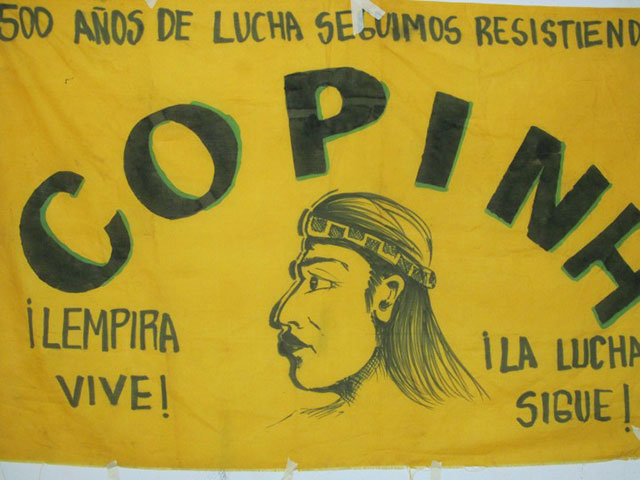
A few numbers begin to reveal why Honduran indigenous leader and global movement luminary, Berta Cáceres, was assassinated on March 3, 2016.
According to the Council of Popular and Indigenous Organizations of Honduras (COPINH), more than 300 hydroelectric dams are planned for Honduras, of which 49 are on COPINH lands. Eight hundred seventy-two contracts have been handed out to corporations for mining alone, with many others created for mega-tourism, wind energy, and logging projects. The majority of these are planned for indigenous lands. Of those, all are in violation of International Labor Organization Convention 169, to which Honduras is a signatory, allowing free, prior, and informed consent by indigenous peoples before development may take place in their territories.
The many planned extraction projects — in a country slightly larger than the state of Virginia — add up to the need of the Honduran and US governments to subjugate the population. Quiescence and compliance are essential for the national elite and multinational corporations to make their profits. So here are a few more relevant numbers. Honduras has 12,000 soldiers — one for every 717 people, for a county not expected to go to war. Its 2013 “defense” budget was $230 million. There are between 10 and 12 US bases in Honduras. Since 2009, the US has invested as much as $45 million in construction funds for just one of those bases, Soto Cano, commonly known as Palmerola. Last year, US taxpayers footed $5.25 million in direct military aid, and much more in training for 164 soldiers at the School of the Americas/Western Hemisphere Institute for Security Operation. Three hundred seventy-two US military personnel are in the country.
Given that state control is often attained through violence, a few more figures become relevant. One hundred one environmental activists were killed in Honduras between 2010 and 2014, making it the most dangerous country anywhere in which to try to defend the Earth.
Nine land defenders were attacked March 15, between the time we began writing this article and when we completed it. COPINH member Nelson Garcia, who had been helping recover lands on Rio Lindo, was assassinated in his home on March 15 while the Rio Lindo community was forcibly evicted. This brings to 14 the number of COPINH members who have been murdered since the group was founded in 1993. A member of COPINH’s coordinating committee, Sotero Echeverria, was threatened with capture by police. Echeverria is one of the3 members of the group who have been framed by the government for Berta’s murder.
Also yesterday, early in the morning, police agents arrested 7 members of United Campesino Movement of the Aguan (MUCA by its Spanish acronym), including the president, Jose Angel Flores. Flores and six other MUCA activists, including his family members, were arrested and taken to the police station. Flores has protective measures from the Inter-American Commission on Human Rights because of the danger he, like all those organizing in the Bajo Aguan region, face. Berta did, too. Protective measures have the weight of toilet paper with the Honduran government.
Despite the ongoing violence, COPINH, MUCA, and other Honduran organizations and movements — workers, campesinos, feminists, and more — have resisted the attempts to subdue them. As Berta loved to say about the movement, “They fear us because we are fearless.”
Of the countless Hondurans who put their bodies on the line every day, no individual has more prominently encouraged or strategically organized dissent than Berta. No Honduran has more visibly spread the message of rebellion to the Americas, nor more audibly urged that rebellion to spread throughout the Americas. “Our call to this continent is that we really push the need to unite ourselves and to create strategies between social movements and left governments,” Berta told a large international gathering of prominent leftists in Havana in 2009.
Berta’s last stand was against a dam being illegally constructed on the sacred Gualcarque River in the community of Rio Blanco. In addition to the internationally financed company DESA, behind the dam was the World Bank, and the largest dam company in the world, Sinohydro, which is owned by the Chinese government. For more than a year and a half, the villagers of Rio Blanco were able to halt the dam construction with nothing more than their bodies, a small trench and fence across the road leading to the river, and their political militance. Berta and others, meanwhile, took the case to the world, building worldwide alliances which brought enough pressure to force the World Bank and Sinohydro to pull out.
Adding insult to injury to those seeking to control water, minerals, forests, and lands, for her work in stopping the dam Berta won the 2015 Goldman Prize, the equivalent of a Nobel for environmental defense. With the award, Berta’s prestige skyrocketed, further threatening domination by the political and economic powers that be. In her acceptance speech, knowing that behind her stood tens or hundreds of thousands of other Hondurans toiling for justice, Berta dedicated her prize in part, to “rebellion.”
This was too much for DESA and the Honduran government. The multi-year efforts to eliminate Berta — through threats, kidnaping attempts, charges of sedition, and more — finally succeeded in the form of a bullet piercing her flesh. Who hired the assassin is unknown. What is known — given very explicit statements and actions of the company and the government in the days and weeks preceding her assassination — is that both were behind the act.
Yet even death cannot subdue Berta. In the days since her murder, the notoriety of her person and her message has multiplied exponentially around the word. The current level of global action against Honduran government impunity, US government’s support for it, and pillaging by transnational capital has reached heights that Berta could only have dreamed of. Click here for actions you can take in solidarity.
Below, we rerun excerpts from the story of COPINH’s fight for Rio Blanco, as told through a photo-essay published in 2013.
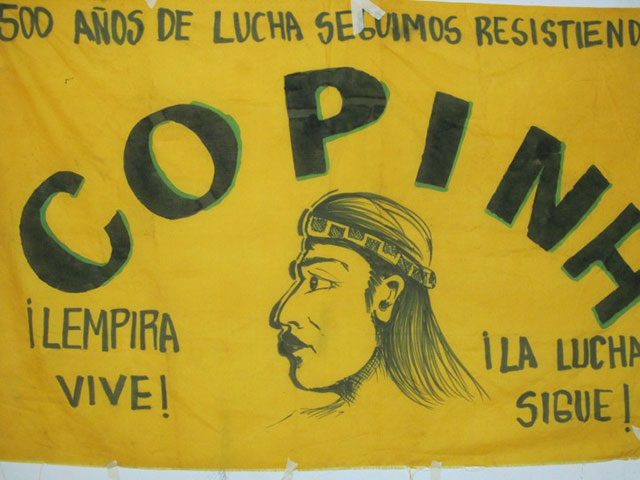
Defending Lenca lands. A flag in a community center of COPINH shows Lempira, the Lenca chief who led the resistance to Spanish colonists in the 1530s. The text reads: “500 years of struggle, we will continue resisting. Lempira lives! The struggle continues!”

This installation was installed illegally on the sacred Gualcarque River in Rio Blanco by the Honduran-owned, foreign-supported damming company DESA. The complex has been base of operations for building and running a dam in the community. The installation was constructed against the will of Rio Blanco’s inhabitants, in violation of the UN Declaration on the Rights of Indigenous Peoples and International Labor Organization Convention 169, which require that indigenous peoples give free, prior, and informed consent to development projects on their lands.
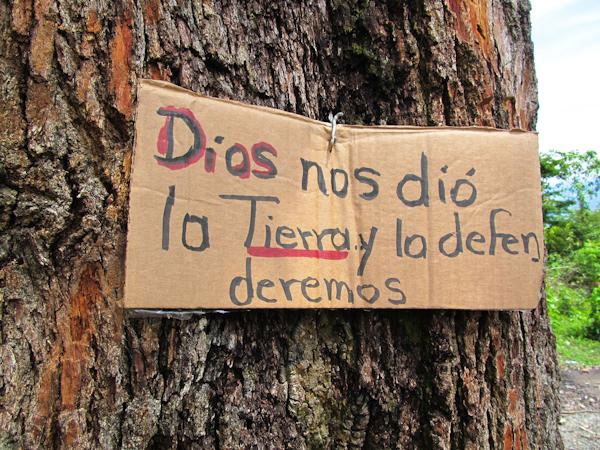
A tree at the entrance of Rio Blanco hosts the message, “God gave us this land and we will defend it.” The community of Rio Blanco declared its road closed to the dam construction. It has been blockading access to the company for five months.
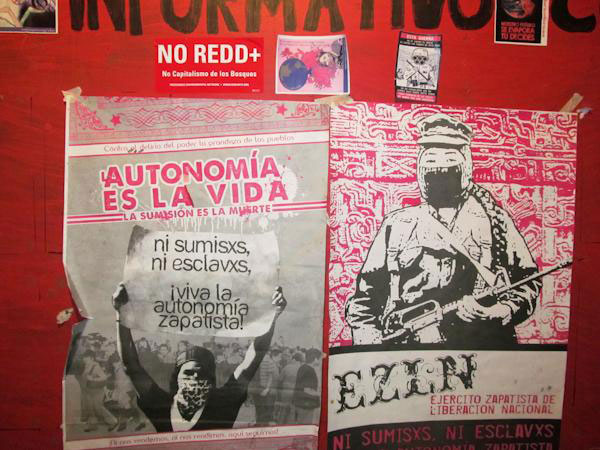
The indigenous movement in Honduras lacks the global attention and left glamour of similar movements elsewhere. Continual deaths and attacks by the military and company-paid goons go largely unpublicized and unnoticed. Yet COPINH feels deeply connected to indigenous autonomy movements around the world, especially the Zapatistas, as seen at the entrance to their national radio station.
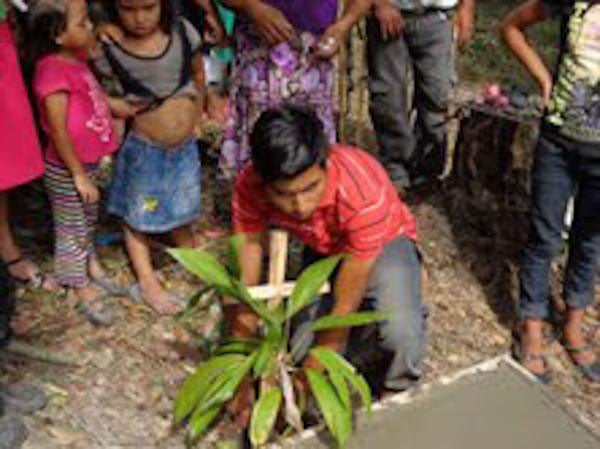
As is happening throughout the country, indigenous people in Rio Blanco are being attacked physically, politically, and legally. On July 15, a soldier shot community leader Tomás Garcia multiple times at close range. He died immediately. A member of the Indigenous Council and of COPINH, Tomás had been offered 20,000 Lempiras (US$980) to support the dam project. Despite being extremely poor and needing to provide for his large family, he refused to sell out. Tomás was laid to rest in the community cemetery, surrounded by the riches of Mother Earth he had fought to defend. Here, one of his six children places flowers on his grave.
Company goons shot one of Tomas’ young sons twice, just in front and behind his heart., and hacked Tomas’ sister and brother-in-law with machetes. When we gave our condolences to Tomas’ sister, she looked down and said, “We’re going to take care it doesn’t happen again.” Then her expression sharpened and she said, “Screw the company trying to take our river, and the government. We’re going to defend our community and our lands. If I die, I’m going to die defending life.”
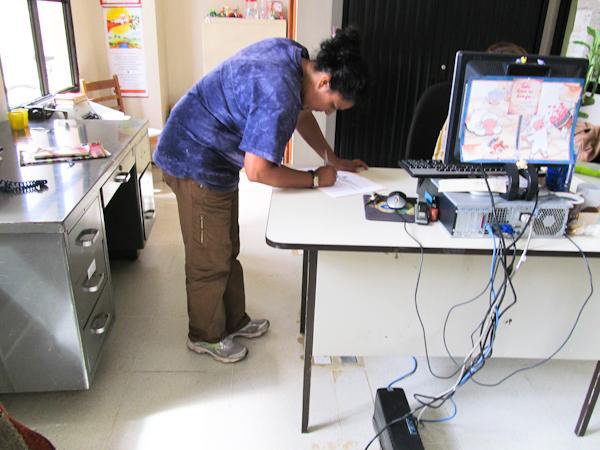
One of the charges brought against COPINH leader Berta Cáceres is illegal possession of a weapon “in contravention to the internal security of Honduras.” She and two others, Aureliano Martínez and Tomás Gomez, have also been charged with “continual danger” to the security of the nation and “invasion of land” against the company… never mind that the company invaded Lenca land. The government’s goal is to decapitate the movement, putting Lenca leaders in jail so that the corporations can continue their extractions unimpeded. The trial of the three is September 12, 2013. Here, Berta is shown signing in at the local courthouse, as she has been ordered to do each Friday. She has also been prohibited from going to the “scene of the crime” — the river in Rio Blanco — and leaving the country.
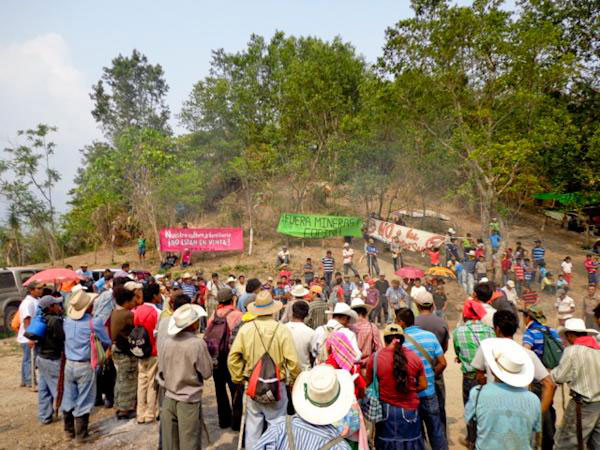
The Rio Blanco community at its blockade of the dam. COPINH member Aureliano Molina, one of the three who will go to trial on September 12 for being a danger to the nation, said, “We don’t negotiate life.”

The community turned out to support Berta in front of the courthouse in La Esperanza in one of the numerous times she has been the victim of trumped-up charges. Berta said, “We always hold the spirit high, as Lempira did. And we remember the spirits who live in the Gualcarque River. Nature has living spirits, too, and they know that we are struggling to support them.”
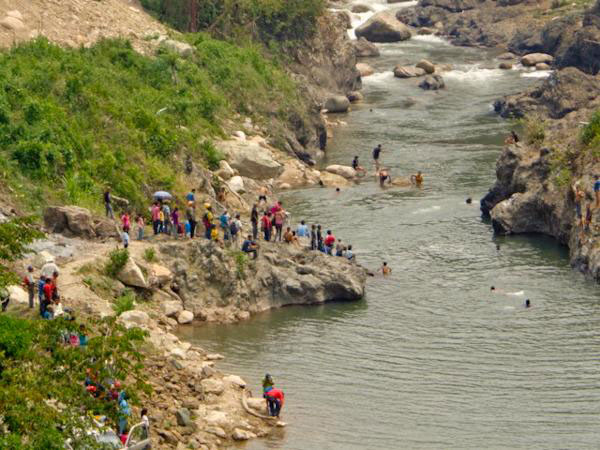
On August 30, DESA withdrew its damming equipment from the Rio Gualcarque. This is a victory for the resistance of the community, but it may be Pyrrhic. COPINH has learned of secret plans, if the right-wing party wins the November elections, for the government and company to move forward with the dam and to crack down even more viciously against indigenous peoples who refuse to submit. Meanwhile, residents of Rio Blanco swim in the river.
24 Hours Left: All gifts to Truthout now matched!
From now until the end of the year, all donations to Truthout will be matched dollar for dollar up to $18,000! Thanks to a generous supporter, your one-time gift today will be matched immediately. As well, your monthly donation will be matched for the whole first year, doubling your impact.
We have just 24 hours left to raise $18,000 and receive the full match.
This matching gift comes at a critical time. As Trump attempts to silence dissenting voices and oppositional nonprofits, reader support is our best defense against the right-wing agenda.
Help Truthout confront Trump’s fascism in 2026, and have your donation matched now!